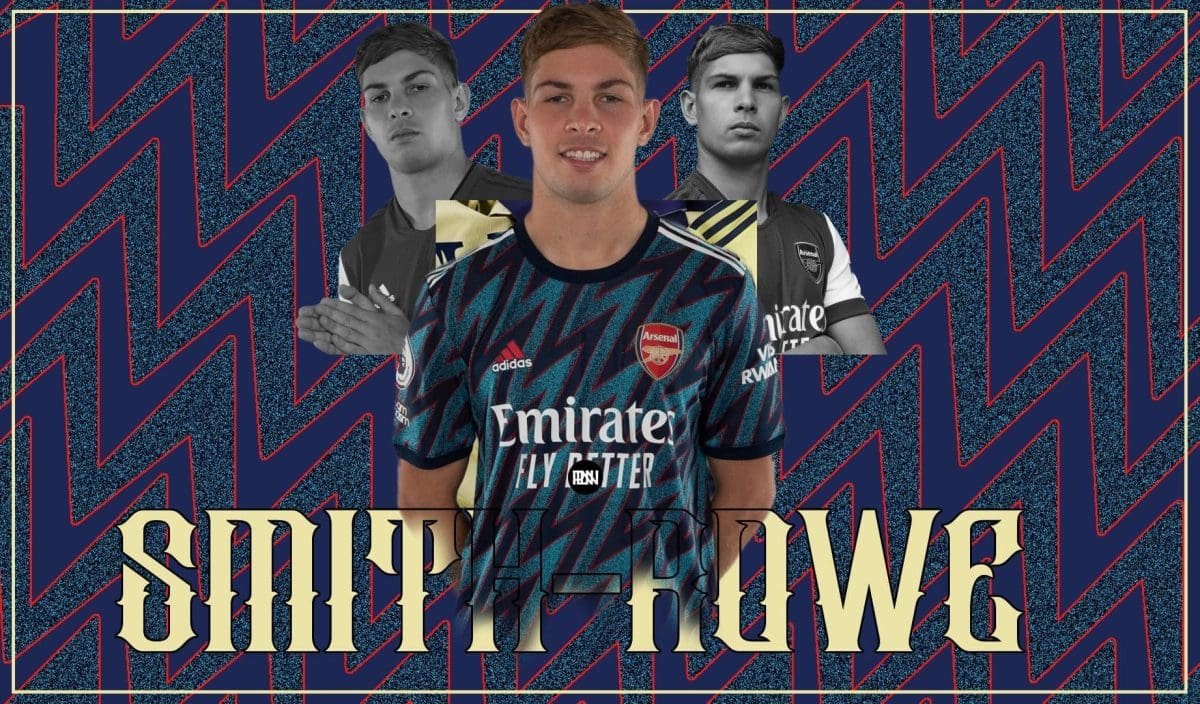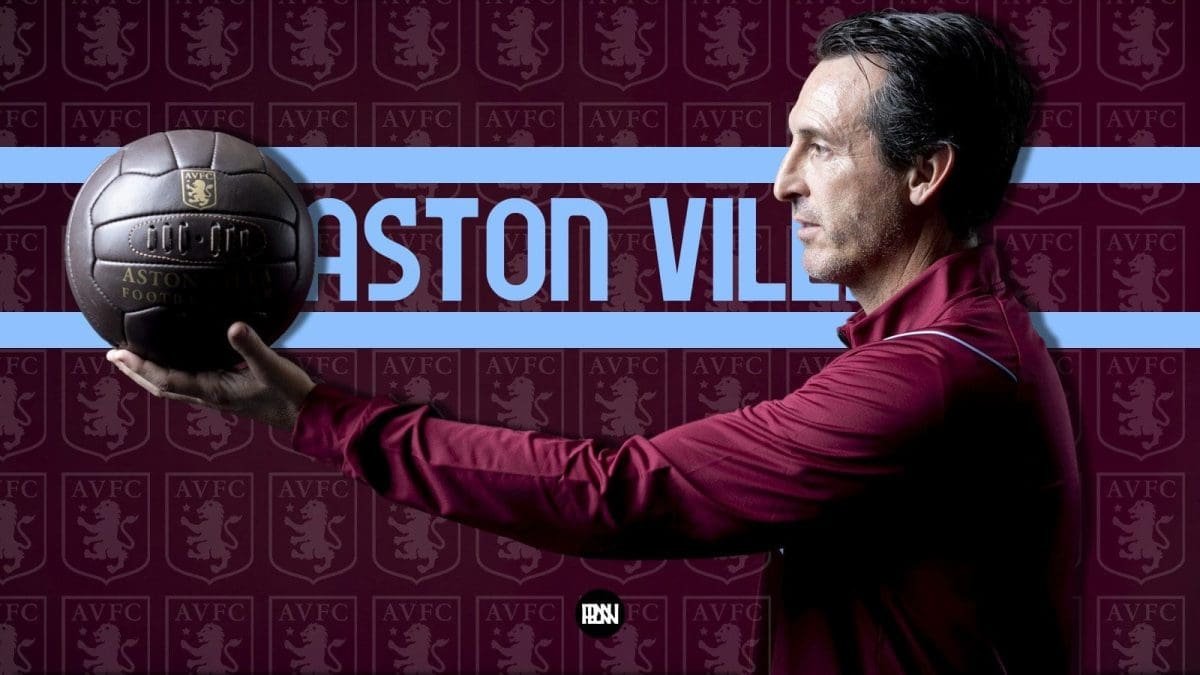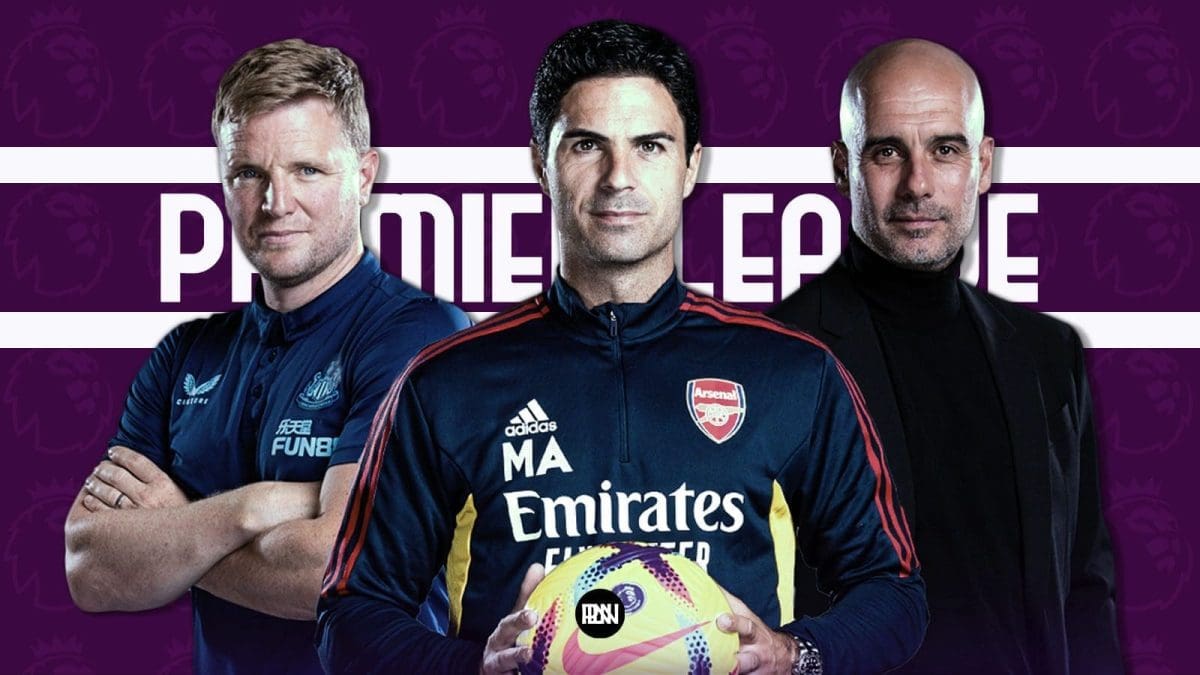With the clock approaching the final quarter of an hour and England leading Albania by five goals to nil in a showcase of utter dominance, the stage was set for Emile Smith Rowe to come on for his Three Lions debut under the Wembley sky in front of a near-capacity crowd. There could not have been an easier game for the Arsenal starlet to make his international debut in, and when Gareth Southgate called upon his services, the Gunners fans watching from all around the globe and in the stadium would’ve had their hearts swell with pride as the humble boy from Croydon ticked off yet another step in his career.
From only featuring in the less important Cup games for Arsenal to making his England debut, it has been an incredible year for Smith Rowe, and those watching from afar will say that his rise to the top has been meteoric, and while that might be true to an extent, long-time followers will say that Emile Smith Rowe was always an explosion waiting to happen. But what is it that makes this 21-year-old so special? How has he been so influential in Arsenal’s turnaround?
Having broken into the side only seven months earlier, when the manager Mikel Arteta handed him the prestigious #10 shirt, it was certainly a big call. But it was the right call. For Arsenal fans, it made sense. It made sense that a product of Hale End and one of their own wore the #10 shirt. In the eyes of the fans, Smith Rowe was worthy of that shirt. Having been thrown in at the deep end against Chelsea on Boxing Day, the Hale Ender came out with flying colours in a performance that served as a teaser for what was to come from him as he went on to become an integral part of the team.
Style of Play
Despite a few appearances coming in off the left, Mikel Arteta predominantly used Smith Rowe in the no.10 position last season, utilizing the England international’s dynamism to great effect as part of a fluid attacking quartet. Smith Rowe’s tendency to exploit the half-spaces with his in-to-out runs was apparent right from the start, as he continually exploited that left channel time and again to cause Chelsea problems aplenty on the night that would eventually prove to be a turning point in Arsenal’s season.
This willingness to always make positive movements further up the pitch is a big part of Smith Rowe’s game, and his role in Saka’s goal in Arsenal’s first game of the calendar year, away at West Brom on a snowy night, perfectly encapsulates the type of player that he is.

Smith Rowe has already seen the space in behind that had opened up with Saka moving inside, and after passing the ball to Saka, he doesn’t stand there admiring the pass, no, he’s already on the move to get into the vacant half-space to make himself available for the return pass.

These third man runs became a real feature of Smith Rowe’s game, especially whenever Lacazette was playing up front. Smith Rowe sharing a telepathic relationship with Saka is of no surprise, considering the two had risen through the ranks playing alongside each other for years, but during this time, he had also developed a great understanding with Lacazette, as the trio once again combined to great effect in the very next game against Newcastle in the FA-Cup.

As soon as Ciaran Clark intercepts Saka’s attempted pass to Lacazette, Smith Rowe is immediately on the move to anticipate where the next pass is going to be. Clark has a loose touch and Smith Rowe steps in to regain the ball having perfectly positioned himself to make the interception. He lays it out to Saka who chips the ball into Lacazette, and with Ciaran Clark getting caught out of position, the two remaining Newcastle center backs are forced to follow Lacazette, which opens up a little pocket of space for Smith Rowe to run into. Lacazette manages to outmuscle Isaac Hayden and heads the ball into Smith Rowe’s path, who chests it down and applies a measured finish across goal into the bottom corner.
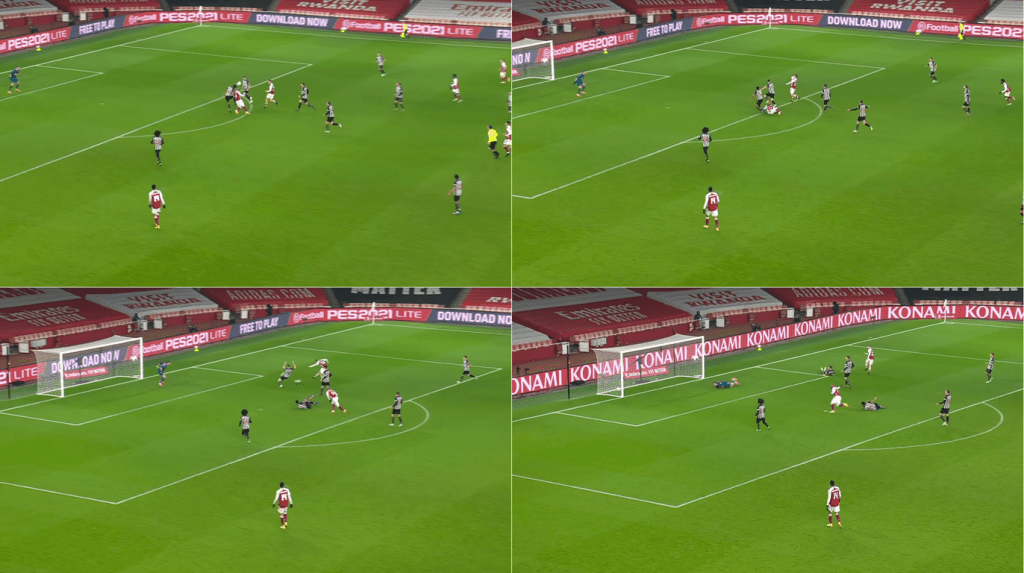
Once again, it’s this willingness to constantly be on the move is what makes the goal. Smith Rowe’s heatmap from last season also highlights this facet of his play, with the half-spaces and wide areas on either side heavily concentrated, showcasing his tendency to often drift into these areas.
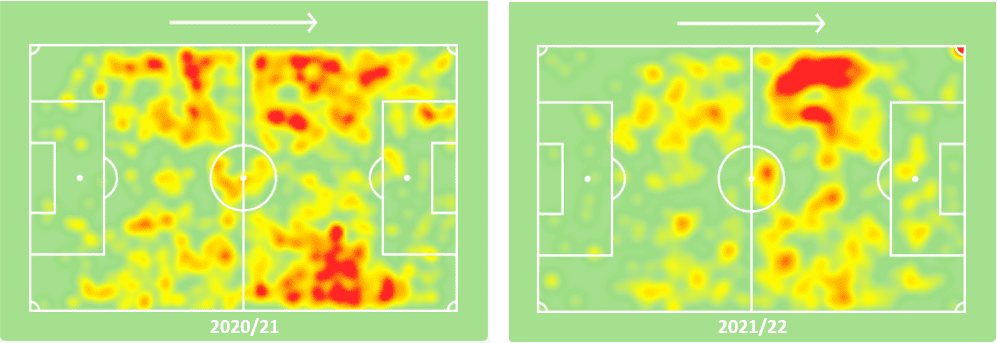
His role has however changed slightly this season. Despite starting the season in the no.10 position, the acquisition of Odegaard, the inclusion of Lacazette and the slight modification of the team structure has seen Smith Rowe being deployed from the left side.
Since the start of this season, Smith Rowe has spoken about adding more goals to his game, saying how he’s been working extra sessions to improve on his shooting and finishing ability, and this change in team setup is tailored towards bringing out the goalscorer in Smith Rowe, with the England international being afforded greater freedom in the final third with his out-to-in runs coming in from the left. With Aubameyang’s positioning in the box and Lacazette often going wide or dropping deep and taking the defenders with him, it opens up little pockets of space in central areas which Smith Rowe is very good at exploiting with his intelligent off-the-ball movement. This is precisely why Lacazette is in the side, and it’s no coincidence that Smith Rowe’s recent goal-scoring run has coincided with the Frenchman’s return to the side.
Different patterns of play structured around getting Smith Rowe into these spaces were apparent in Arsenal’s most recent game against Watford.
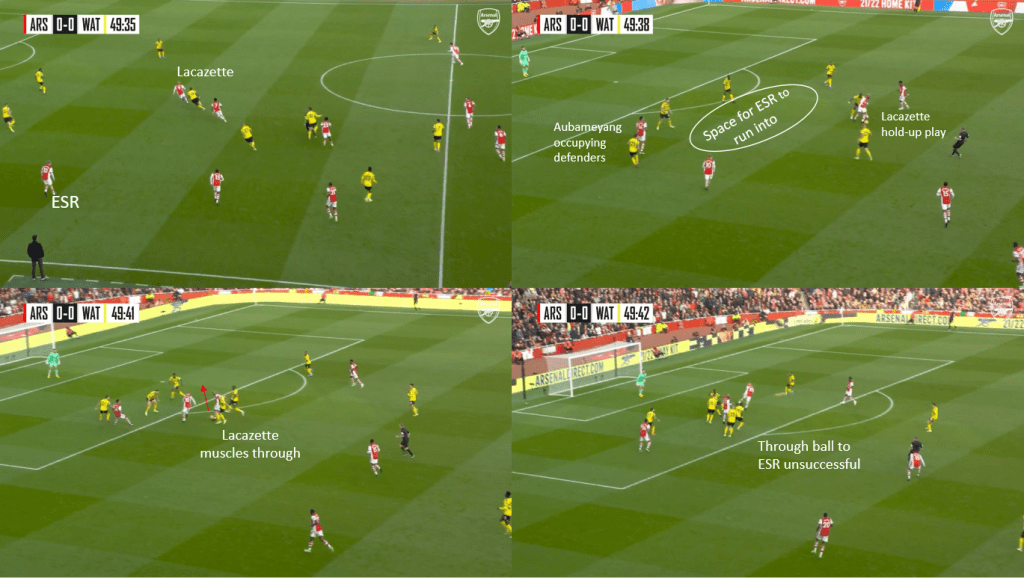
At the start of the second half, Lacazette’s movement to drop off and link play opened up spaces further up the pitch for Smith Rowe to exploit. With Aubameyang’s position on the last line pinning the defenders back on one side, Smith Rowe was free to make the diagonal run across and would’ve been in on goal had Lacazette managed to poke the ball through following some good hold-up play.
Smith Rowe had made another similar run barely a minute later as Arsenal once again carved through the Watford defense.
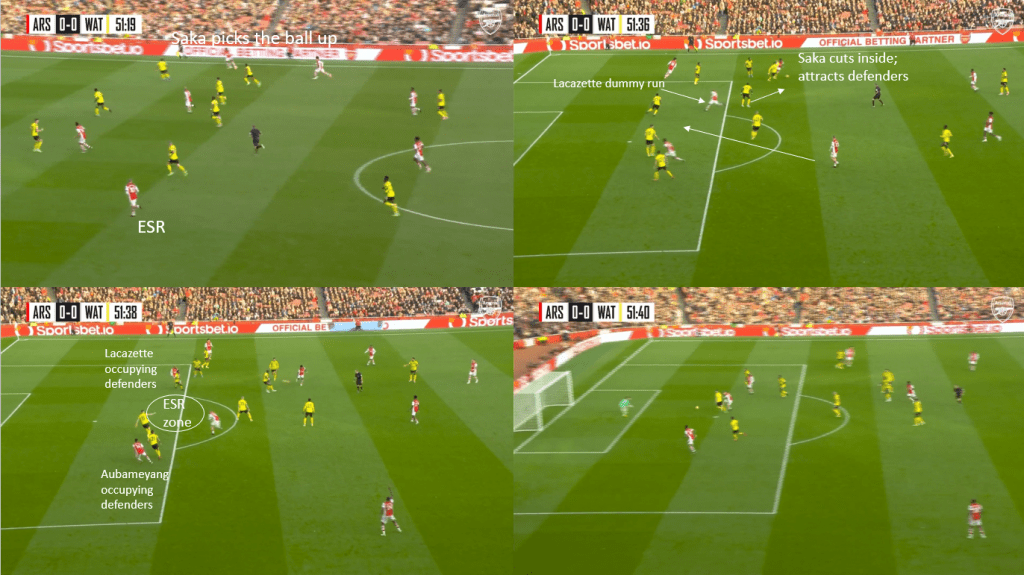
Saka picks the ball up wide on the right-hand side and drives through the Watford defense, cutting inside onto his stronger left foot as he attracted defenders towards him, while simultaneously, Lacazette’s arching run into the right-half space, in combination with Aubameyang’s position in the box pinning the defenders back on one side, meant that a vacant space had once again opened up for Smith Rowe to exploit in the central areas, and had he managed to get on the end of Saka’s ball, he would’ve been in on goal.
It was no coincidence the goal came when it came. Smith Rowe had been making more of these runs at the start of the second half and was always loitering around the edge of the box, which is where he was when the ball fell to him for the goal.

On this occasion, Lacazette had drifted out to the right to assist in the build-up, causing Smith Rowe to take up an attacking position inside the box. Lacazette’s cross is cleared, but it’s cleared straight out to Ben White, who embarks on another one of his mazy dribbles. And when Ben White gets tackled, Smith Rowe comes alive to pounce onto the loose ball before any of the Watford players can react.
His goal against Leicester is another great example of how he’s always expecting the loose ball to drop his way, and the fact that he hits the ball first-time with such conviction, whilst using the defenders in front of him as a shield, is a telling fact as to how he has already seen a picture of it in his head as the ball was rolling out to him. It’s a skill that not all players possess, and Emile Smith Rowe is beginning to learn to harness that skill within him.

GREATER EYE FOR GOAL
Between the end of last season and the start of this season, it’s Smith Rowe’s shooting ability that has improved the most. Although in this new role he is passing the ball less when compared to last season, Smith Rowe is firing off twice as many shots and with much greater efficiency as well. The greater xG further indication of Smith Rowe finding himself in better goal-scoring positions this term.

When comparing his shot maps, its clear to see that Smith Rowe has cut down on taking speculative efforts from distance and has instead prioritized on taking shots from inside the box, which is a more natural fit for his style.
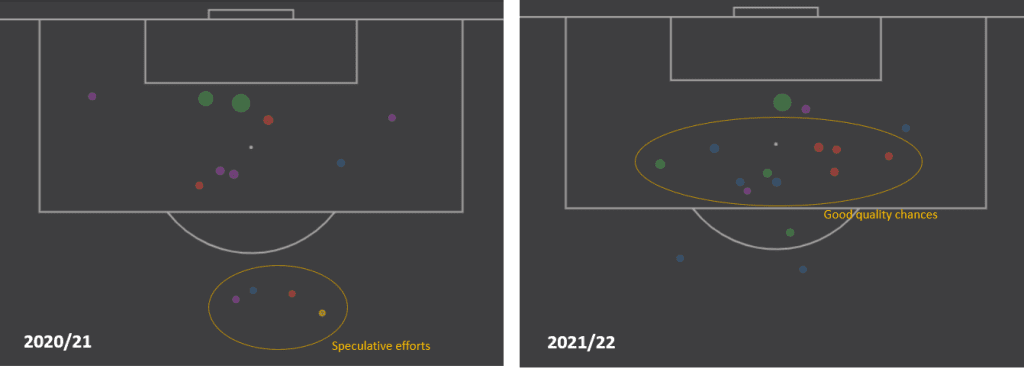
A DIRECT APPROACH TO GOAL
Smith Rowe has always been a good progressor of the ball. The ability to run with the ball at feet is always an effective way to bring your team up the pitch and turn defense into attack in the blink of an eye. This sort of directness is another huge part of Smith Rowe’s style of play, has been from his days in the academy.

Smith Rowe’s wide starting position on the left allows him the possibility for more take-ons, and the 21-year-old has certainly capitalised on it, attempting more dribbles this term and at a far greater success rate as well, a further indication of the direct approach he has taken this season. The proof is once again in the pudding with this one, with his assist for Aubameyang in the North London derby and the goal against Villa showcasing Smith Rowe’s ability to run with the ball and progress the team forward.
RELENTLESS WORK RATE
Staying on that goal against Villa, not only was that a blistering counterattack from Arsenal, but it was a goal that showcased all of Smith Rowe’s good qualities, starting from the way in which he regained the ball, constantly checking his shoulder to be aware of Matty Cash’s position and getting across to cut out the pass to the right-back, to then exploiting the space in behind as he controlled Aubameyang’s ball over the top with his head before running through on goal and applying the finish, which although fortuitous, was no less than what he deserved.


Smith Rowe has never been one to shy away from the dirty side of the game. He’s a hard worker off the ball, always diligent in carrying out his defensive duties and a willing presser from the front. No better example indicative of this fact than his winner at Stamford Bridge last season as he proved that even the best can be pressurized into committing mistakes when he went breathing down Jorginho’s neck as Chelsea were building out from the back. The Italian could feel the Arsenal man snapping at his heels, which forced him into an uncharacteristic mistake. Even as it looked like the ball might be heading in, Smith Rowe doesn’t stand there admiring his work, he follows up into the box to get into a scoring position in the event of a save. While in stark contrast, Jorginho, the man who was supposed to be picking up Smith Rowe, is stood there rueing his mistake.
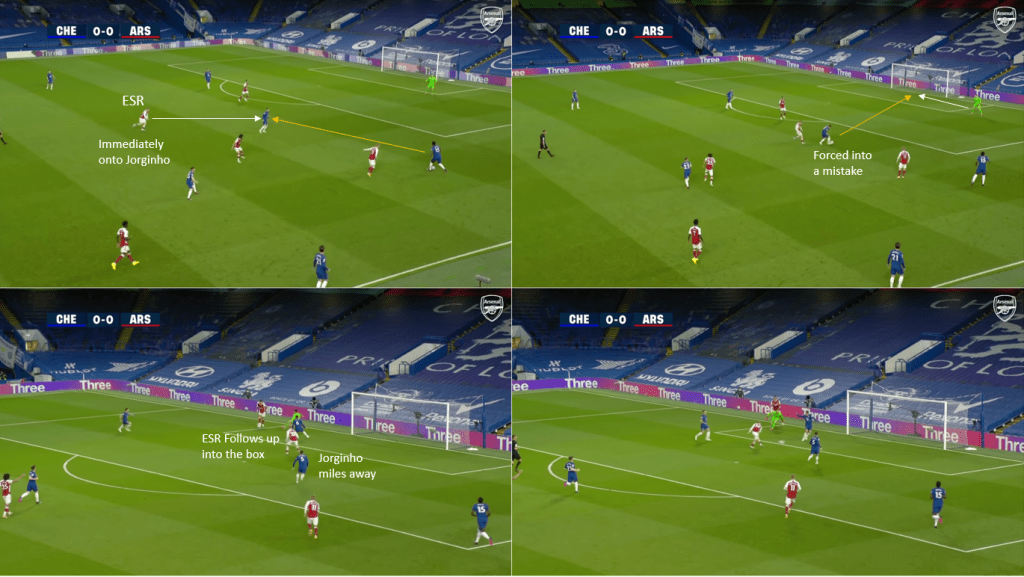
This attitude of always wanting to force things into action almost helped create a goal out of nothing earlier this season at the Etihad, when Smith Rowe’s relentless pressing, even when down by two goals, almost caught Ederson out.
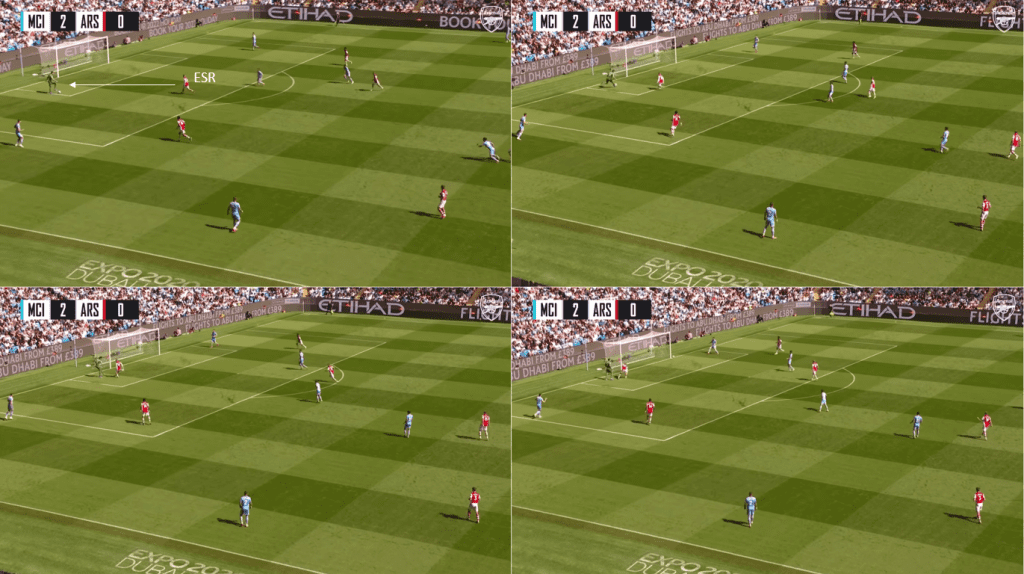
WHAT NEXT FOR EMILE?
Since the departure of Aaron Ramsey, Arsenal have been screaming for a player capable of scoring goals from midfield, and in Smith Rowe, the Gunners may finally have their man. It wouldn’t be wrong in saying that Smith Rowe has shades of Ramsey in his game, but where the latter struggled for fitness during his time in North London, the former is already making strides in that area, changing his lifestyle from a young age itself as he attempts to set a strong foundation for a long career. Smith Rowe has made no secret of his desire to be a one-club man. He’s a player who genuinely loves the club and the fans, celebrates every goal with such pure passion like it is his first. The cannon of the Arsenal does weigh heavy, and the no.10 shirt large in stature, but the rate at which Smith Rowe continues to grow, he will be shouldering the entire weight of the cannon on his own before too long.
MUST READ:
– Martin Odegaard: Arsenal’s very own Luka Modric
– Why is Granit Xhaka so hard to replace at Arsenal?
– Pierre-Emerick Aubameyang isn’t a finished article
– Charlie Patino: The Rolls-Royce midfielder Arsenal have been brewing in their ranks
– Should Arsenal be looking at Mattias Svanberg?


